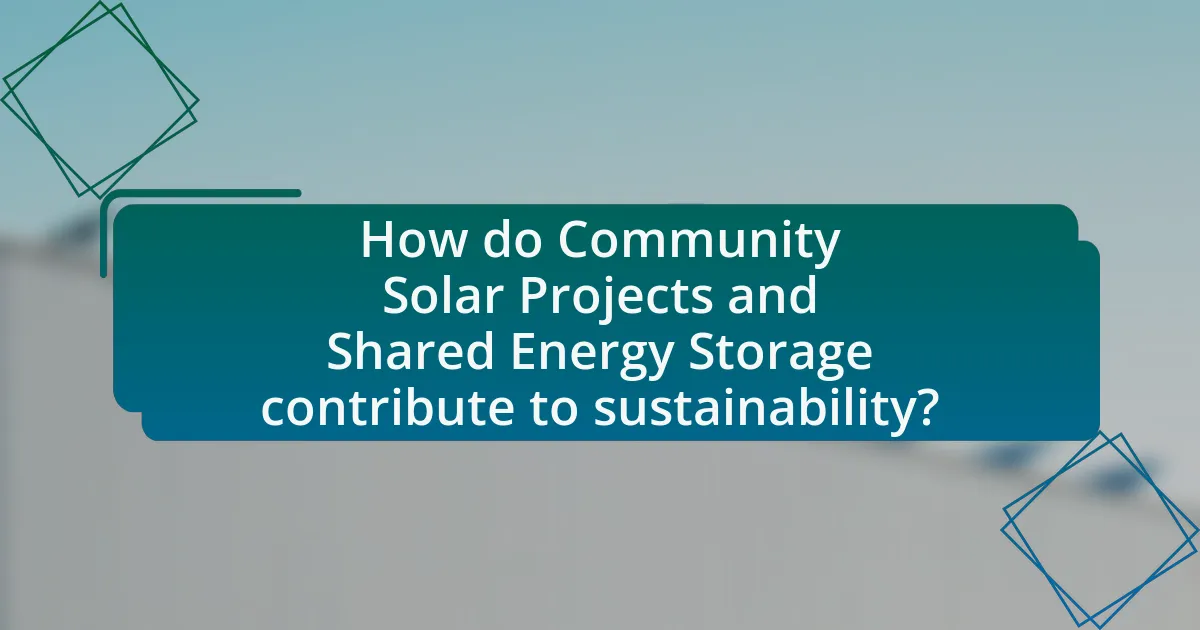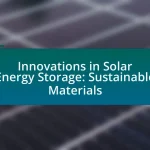Community solar projects are collaborative initiatives that enable multiple participants to invest in or benefit from shared solar energy systems, providing access to renewable energy without the need for individual solar panel installations. This article explores the operational mechanisms of community solar projects, including their key components, benefits, and the role of shared energy storage in enhancing efficiency and reliability. It also addresses the environmental impacts, economic advantages, and challenges associated with these projects, while highlighting best practices and supportive policies for sustainable development. The integration of shared energy storage is emphasized as a crucial factor in optimizing energy use and reducing carbon emissions, ultimately contributing to a more sustainable energy landscape.
What are Community Solar Projects?


Community solar projects are initiatives that allow multiple participants to invest in or benefit from a shared solar energy system. These projects enable individuals, businesses, and organizations to access solar power without needing to install solar panels on their own properties. Typically, community solar projects are developed on a larger scale, such as on vacant land or rooftops, and the energy produced is distributed to subscribers, often resulting in reduced electricity costs. According to the National Renewable Energy Laboratory, community solar can increase access to renewable energy for those who may not have suitable rooftops for solar installations, thus promoting wider adoption of clean energy solutions.
How do Community Solar Projects operate?
Community solar projects operate by allowing multiple participants to invest in or subscribe to a shared solar energy system, typically located off-site. These projects generate electricity that is fed into the local grid, and the energy produced is credited to the participants’ utility bills based on their share of the investment or subscription. This model enables individuals, businesses, and organizations to benefit from solar energy without needing to install solar panels on their own properties, thus promoting wider access to renewable energy. According to the National Renewable Energy Laboratory, community solar can increase solar adoption among those who may not have suitable rooftops or the financial means to invest in solar technology directly.
What are the key components of Community Solar Projects?
The key components of Community Solar Projects include solar arrays, subscription models, and community engagement. Solar arrays are the physical installations that generate electricity, typically located on unused land or rooftops. Subscription models allow community members to buy or lease a portion of the solar energy produced, enabling access to renewable energy without the need for individual installations. Community engagement is crucial for educating participants about the benefits and logistics of the project, fostering a sense of ownership and collaboration among members. These components work together to create a sustainable energy solution that benefits both the environment and the community.
How is energy generated and distributed in Community Solar Projects?
Energy in Community Solar Projects is generated through solar panels installed in a shared location, typically on rooftops or ground-mounted systems. These solar panels convert sunlight into electricity, which is then fed into the local power grid. The generated energy is distributed to participating community members based on their subscription or ownership of a portion of the solar array. This model allows individuals who may not have suitable rooftops for solar installations to benefit from renewable energy. According to the National Renewable Energy Laboratory, community solar projects can increase access to solar energy for low-income households and renters, promoting equitable energy distribution.
What are the benefits of Community Solar Projects?
Community solar projects provide multiple benefits, including increased access to renewable energy, cost savings, and environmental sustainability. These projects allow individuals and businesses who may not have suitable rooftops for solar panels to participate in solar energy generation, thus broadening the reach of clean energy. According to the National Renewable Energy Laboratory, community solar can reduce energy costs for participants by up to 10% compared to traditional energy sources. Additionally, these projects contribute to reducing greenhouse gas emissions, as they promote the use of clean energy and decrease reliance on fossil fuels.
How do Community Solar Projects promote renewable energy adoption?
Community Solar Projects promote renewable energy adoption by providing accessible solar energy options to individuals and communities who may not have the means to install solar panels on their properties. These projects allow participants to invest in or subscribe to a shared solar array, which generates clean energy that is credited to their utility bills. According to the National Renewable Energy Laboratory, community solar can increase solar adoption rates by making renewable energy available to renters, low-income households, and those with unsuitable roofs for solar installations. This inclusivity fosters a broader acceptance and utilization of renewable energy sources, ultimately contributing to a more sustainable energy landscape.
What economic advantages do Community Solar Projects provide to communities?
Community Solar Projects provide significant economic advantages to communities by reducing energy costs and creating local jobs. These projects allow residents to access solar energy without needing to install panels on their properties, leading to lower electricity bills. According to a report by the National Renewable Energy Laboratory, community solar can reduce energy costs by 10-20% for participants. Additionally, these projects stimulate local economies by creating jobs in installation, maintenance, and management, with the Solar Foundation’s National Solar Jobs Census indicating that the solar industry employed over 250,000 workers in the U.S. in 2019. This combination of cost savings and job creation enhances community resilience and economic stability.
What is the role of Shared Energy Storage in Community Solar Projects?


Shared Energy Storage plays a crucial role in Community Solar Projects by enabling the efficient management of energy supply and demand. This technology allows excess solar energy generated during peak sunlight hours to be stored and utilized during periods of low generation or high demand, thereby enhancing the reliability and stability of the energy supply. Furthermore, Shared Energy Storage can facilitate greater participation in community solar initiatives by allowing multiple users to benefit from a single storage system, thus reducing individual costs and increasing access to renewable energy. Studies have shown that integrating energy storage with community solar can lead to improved grid resilience and lower energy costs for participants, making it a vital component in the transition to sustainable energy systems.
How does Shared Energy Storage enhance the efficiency of Community Solar Projects?
Shared Energy Storage enhances the efficiency of Community Solar Projects by allowing for the storage of excess solar energy generated during peak sunlight hours for later use. This capability mitigates the intermittency of solar power, ensuring a consistent energy supply even when sunlight is not available. For instance, studies have shown that integrating energy storage systems can increase the overall energy utilization rate of solar installations by up to 30%, thereby maximizing the return on investment for community solar projects. Additionally, shared energy storage facilitates load balancing, enabling communities to better match energy supply with demand, which further optimizes the overall efficiency of the solar energy system.
What technologies are used in Shared Energy Storage systems?
Shared Energy Storage systems primarily utilize battery technologies, including lithium-ion, flow batteries, and lead-acid batteries. Lithium-ion batteries are favored for their high energy density and efficiency, making them suitable for various applications in energy storage. Flow batteries, on the other hand, offer scalability and longer discharge times, which are beneficial for larger energy storage needs. Lead-acid batteries, while older technology, are still used due to their low cost and reliability in specific applications. These technologies enable the storage and distribution of energy generated from renewable sources, thereby enhancing the efficiency and sustainability of community solar projects.
How does Shared Energy Storage impact energy reliability and availability?
Shared Energy Storage enhances energy reliability and availability by providing a buffer that balances supply and demand fluctuations. This system allows for the storage of excess energy generated during peak production times, such as sunny or windy days, which can then be released during periods of high demand or low generation. For instance, a study by the National Renewable Energy Laboratory found that integrating shared energy storage with community solar projects can increase grid reliability by up to 30%, ensuring a more stable energy supply. Additionally, shared energy storage systems can reduce the need for peaker plants, which are often less efficient and more polluting, thereby improving overall energy availability and sustainability.
What are the environmental impacts of Shared Energy Storage in Community Solar Projects?
Shared Energy Storage in Community Solar Projects primarily reduces greenhouse gas emissions by enabling the efficient use of renewable energy. By storing excess solar energy generated during peak sunlight hours, these systems minimize reliance on fossil fuels during periods of high demand or low solar generation. This transition to cleaner energy sources contributes to improved air quality and reduced environmental degradation. Additionally, Shared Energy Storage can enhance grid stability and resilience, further supporting the integration of renewable energy into the energy mix. Studies indicate that implementing such systems can lead to a significant decrease in carbon emissions, with estimates suggesting reductions of up to 30% in some regions.
How does Shared Energy Storage contribute to reducing carbon emissions?
Shared Energy Storage contributes to reducing carbon emissions by enabling the integration of renewable energy sources, such as solar and wind, into the energy grid more effectively. This technology allows excess energy generated during peak production times to be stored and used later, reducing reliance on fossil fuel power plants that typically operate during high demand periods. For instance, a study by the National Renewable Energy Laboratory found that energy storage can reduce greenhouse gas emissions by up to 30% in certain scenarios by displacing fossil fuel generation. By facilitating a more stable and reliable energy supply from renewables, Shared Energy Storage plays a crucial role in minimizing carbon footprints associated with energy consumption.
What are the potential ecological risks associated with Shared Energy Storage?
Shared Energy Storage systems pose several potential ecological risks, including habitat disruption, resource depletion, and pollution. Habitat disruption can occur during the installation and maintenance of storage facilities, which may lead to the loss of local flora and fauna. Resource depletion is a concern due to the extraction of materials needed for batteries, such as lithium and cobalt, which can result in environmental degradation and biodiversity loss. Additionally, pollution risks arise from the potential leakage of hazardous materials from batteries, which can contaminate soil and water sources. These risks highlight the need for careful planning and management in the implementation of Shared Energy Storage systems to mitigate their ecological impact.
How do Community Solar Projects and Shared Energy Storage contribute to sustainability?


Community Solar Projects and Shared Energy Storage significantly contribute to sustainability by promoting renewable energy use and enhancing energy efficiency. Community Solar Projects allow multiple participants to invest in and benefit from solar energy, reducing reliance on fossil fuels and lowering greenhouse gas emissions. Shared Energy Storage systems complement this by storing excess energy generated during peak production times, which can then be utilized during periods of high demand or low generation, thus optimizing energy use and reducing waste. According to the National Renewable Energy Laboratory, integrating energy storage with solar can increase the overall efficiency of the energy system, further supporting sustainability goals.
What are the long-term environmental benefits of Community Solar Projects?
Community Solar Projects provide significant long-term environmental benefits by reducing greenhouse gas emissions and promoting sustainable energy practices. These projects facilitate the generation of clean, renewable energy, which decreases reliance on fossil fuels, thereby lowering carbon dioxide and other harmful emissions. According to the National Renewable Energy Laboratory, community solar can reduce emissions by approximately 50% compared to traditional energy sources. Additionally, these projects enhance local biodiversity by utilizing land in ways that can support native flora and fauna, and they often incorporate sustainable land management practices. Overall, Community Solar Projects contribute to a cleaner environment and support the transition to a more sustainable energy future.
How do these projects support local ecosystems?
Community solar projects support local ecosystems by promoting biodiversity and reducing carbon emissions. These projects often incorporate native plantings and habitats, which enhance local flora and fauna, thereby fostering a healthier ecosystem. Additionally, by generating renewable energy, they decrease reliance on fossil fuels, leading to lower greenhouse gas emissions that contribute to climate change, which negatively impacts ecosystems. Studies have shown that integrating solar installations with ecological practices can improve soil health and water retention, further benefiting local environments.
What role do Community Solar Projects play in combating climate change?
Community Solar Projects significantly contribute to combating climate change by providing renewable energy access to a broader population, thereby reducing reliance on fossil fuels. These projects enable communities to harness solar energy collectively, which decreases greenhouse gas emissions associated with traditional energy sources. For instance, a study by the National Renewable Energy Laboratory found that community solar can reduce carbon emissions by up to 50% compared to conventional energy generation methods. By facilitating local energy production, Community Solar Projects also promote energy independence and resilience, further mitigating the impacts of climate change.
What challenges do Community Solar Projects face regarding environmental impact?
Community Solar Projects face significant challenges regarding environmental impact, primarily related to land use, habitat disruption, and resource consumption. The installation of solar panels often requires large areas of land, which can lead to habitat loss for local wildlife and disruption of ecosystems. For instance, a study by the National Renewable Energy Laboratory found that utility-scale solar projects can occupy between 5 to 10 acres per megawatt, potentially displacing flora and fauna. Additionally, the production and disposal of solar panels involve the use of hazardous materials, which can pose environmental risks if not managed properly. These factors highlight the need for careful site selection and sustainable practices to mitigate negative environmental consequences.
How can these challenges be addressed to maximize positive outcomes?
To address the challenges of community solar projects and maximize positive outcomes, stakeholders should implement comprehensive planning and community engagement strategies. Effective planning involves assessing local energy needs, environmental impacts, and potential barriers to implementation, which can lead to tailored solutions that benefit both the community and the environment. Engaging the community through education and participation fosters support and ensures that the projects align with local values and needs. Research indicates that projects with strong community involvement have higher success rates and greater acceptance, as evidenced by the Solar Energy Industries Association’s findings that community solar programs can increase local job creation and energy equity.
What policies support the development of environmentally friendly Community Solar Projects?
Policies that support the development of environmentally friendly Community Solar Projects include renewable energy standards, net metering laws, and financial incentives such as tax credits and grants. Renewable energy standards mandate a certain percentage of energy to come from renewable sources, encouraging the establishment of community solar initiatives. Net metering laws allow participants to receive credit for excess energy produced, making solar investments more financially viable. Additionally, financial incentives like the Investment Tax Credit (ITC) provide significant tax reductions for solar installations, further promoting the growth of community solar projects. These policies collectively create a favorable environment for the expansion of sustainable energy solutions.
What best practices can be implemented for successful Community Solar Projects?
Successful Community Solar Projects can be implemented by ensuring strong community engagement, transparent communication, and effective financial models. Engaging the community fosters trust and participation, which are critical for project acceptance and sustainability. Transparent communication about project goals, benefits, and processes helps to align community interests with project objectives. Effective financial models, such as subscription-based systems or shared savings, ensure that the economic benefits are accessible to all participants, enhancing project viability. Research indicates that projects with high community involvement and clear financial incentives have a higher success rate, as seen in the Solar Gardens program in Colorado, which has successfully integrated these best practices.


